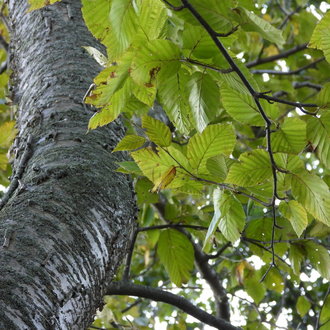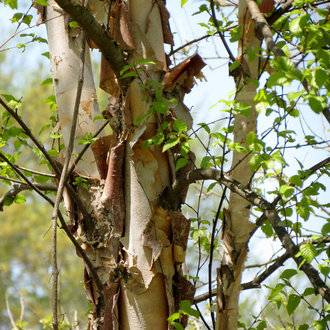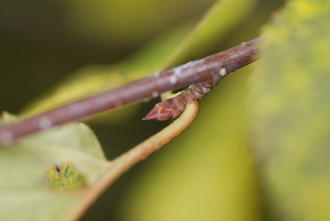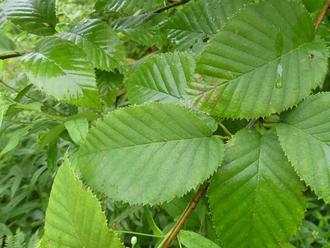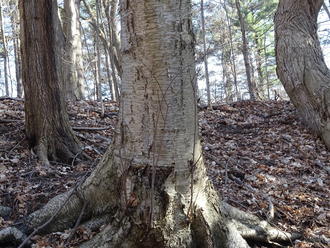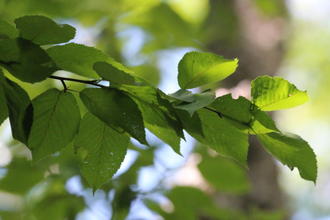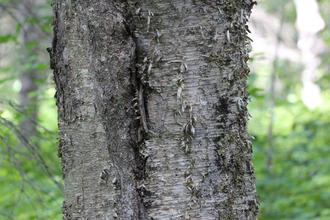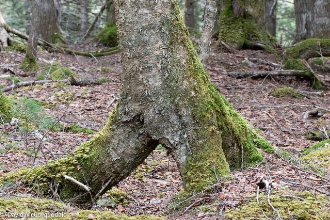Yellow Birch (Betula alleghaniensis Britton)
Also classified as Betula lutea.
↑Summary
A large birch native to northeastern North America, named for the often-yellowish color of its bark.
↑Range - Expand
| Legend | Color |
| Native | |
| Native or Not Present |
This tentative map is based on our own research. It may have limited data on Canada and/or Mexico, and there is some subjectivity in our assignment of plants as introduced vs. expanded. Read more in this blog post.
Although this plant occurs somewhere in each of these regions, it may only occur in a small part of some or all of them.
↑Description & Identification
A large tree, usually 60-75ft (18-23m) tall at maturity, up to 2 feet in diameter.
The bark is gray to yellowish, often shiny, giving a golden appearance, and peels in thin horizontal strips. The bark has prominent horizontal lenticels, like most other birches and like cherries. These horizontal features and the overall smooth bark often extends the whole way to the base of the tree, even evident on large surface roots.
Large, lateral roots are often visible, especially on trees that germinated above the surface of the ground.
Leaves are ovate and have irregularly serrate margins. Leaves have 12-18 lateral veins, rarely fewer.
↑Similar Plants
↑Habitat
Yellow birch is found in forests of the northeast, often as scattered individual canopy trees, intermixed with other species, especially sugar maple (Acer saccharum) and american beech (Fagus grandifolia). It grows on soils derived from many different parent materials. It grows best on well-drained sites but is also common on poorly-drained sites and wetland margins, where its growth is somewhat stunted.
It is drought intolerant, due to a shallow root system, and can only grow on sandier soils on wetter sites and in the cooler parts of its range. Drought limits this species' survival at the southern and western portions of its range in the midwest, and at lower elevations in the Appalachians.
Like other birches, it has high phosphorus requirements.
In mountainous regions, yellow birch is most abundant at the transition zone between lower-elevation hardwood forests and the spruce-fir forests at higher elevations.
Found in a range of successional stages of forests; although less shade-tolerant than other climax species, yellow birch seems to persist in old growth forests by taking advantage of gaps produced when other trees, particularly beech, die.
In much of its range, limited to forests that almost never experience fire, but it is sometimes able to colonize sites where a severe fire has opened the forest canopy.
↑Life Cycle
Seedlings germinate in response to light, and need some direct sunlight for establishment. Germination is most likely to occur on raised objects in a forest, such as logs, rotting stumps, or cracks in boulders. As seeds are small, seedling roots are unable to penetrate thick leaf litter.
Seedlings tend to cluster in suitable conditions, and mortality is very high in the first year. Seedlings do best with some shade, but in mature forests, survival is best in gaps and areas with slightly lighter canopy cover. In mixed coniferous-deciduous forest, some seedlings benefit from decreased canopy cover associated with the pyramidal shape of conifers such as hemlock, fir, and spruce. Late spring frost can kill seedlings.
Surviving seedlings that germinate on a raised object, grow multiple roots down to the soil surface, anchoring the tree, often several feet above the ground. The root system is variable in structure by the site, but trees usually develop extensive lateral roots. Although the root system is usually shallow, roots may penetrate over 5 feet in depth when grown on deep, loamy or sandy-loamy soils.
Trees usually begin producing seed around 40 years of age; seed production usually peaks around 70 years. Open-grown trees may mature faster, producing some seed as early as 7 years, with heavy seed crops as young as 30 years. Heavy seed crops are produced at 1 to 4 year intervals, with very little seed produced in other years, occasionally no seed at all. Overall, seed production is high.
Seed is dispersed by wind in fall and winter, with the seeds traveling the farthest distance when they fall on crusted snow.
Seeds germinate in late spring to early summer, after a period of cold dormancy. Although most seeds germinate in their first year, a substantial amount does not germinate until later. Seeds can remain viable for several years, and the species forms a substantial, short-lived seedbank by virtue of the large volume of seed.
Damaged trees can resprout if young, but overall this species' resprouting ability is poor, and sprouts are usually short-lived. Trees are highly susceptible to fire at all stages in their life cycle. Trees growing on shallow soils sometimes do not anchor themselves and are susceptible to windthrow.
Trees usually live an average of 150 years, but can live over 300 years under good conditions.
↑Uses
Can be used to produce birch beer, although Sweet Birch (Betula lenta) is favored for this purpose due to its higher content of methyl salicylate, the compound responsible for the distinct wintergreen aroma of these two species.
Can be used for producing a sweet syrup, a lot like how sugar maple (Acer saccharum) is used to produce maple syrup.
Used for wood and considered the most valuable of the North American birches by the timber industry. However, still relatively inexpensive relative to other hardwoods. The wood is easy to work with but has poor decay resistance.
↑Related Plants
Yellow birch is closely related to the other birches of North America. It naturally hybridizes with bog birch (Betula pumila) relatively frequently, and paper birch (Betula papyrifera) more rarely, where the species overlap.
↑Links & External Resources
• Yellow Birch | The Wood Database (About This Site)
• Yellow Birch | Fire Effects Information System (FEIS) (About This Site)
• Betula alleghaniensis (Yellow Birch) | Illinois Wildflowers (About This Site)
• Betula alleghaniensis (Yellow Birch) | USDA PLANTS Database (About This Site)
• Betula alleghaniensis | Go Botany (About This Site)
• Yellow Birch | Virginia Tech Dendrology Factsheets (About This Site)
• Yellow Birch | Silvics of North America (About This Site)
• Betula alleghaniensis | Biota of North America Project (BONAP) (About This Site)
• Betula alleghaniensis | NatureServe Explorer (About This Site)
• Betula alleghaniensis | Flora of North America (About This Site)
• Yellow Birch | Maryland Biodiversity Project (About This Site)
• Betula alleghaniensis Britt. (Yellow Birch) | Digital Atlas of the Virginia Flora (About This Site)



